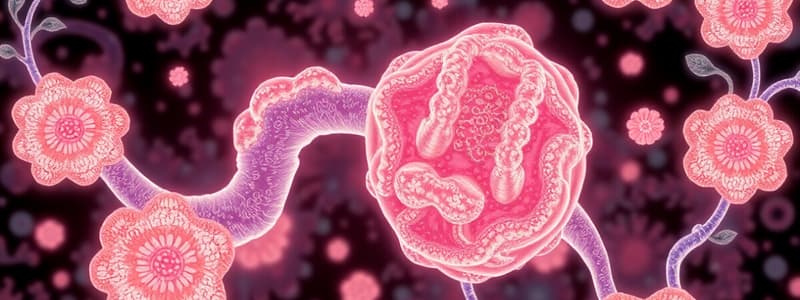Podcast
Questions and Answers
What is the primary role of MHC molecules in antigen presentation?
What is the primary role of MHC molecules in antigen presentation?
Which type of antigen do T cells primarily recognize?
Which type of antigen do T cells primarily recognize?
Which compartments are primarily involved in antigen processing for T cell recognition?
Which compartments are primarily involved in antigen processing for T cell recognition?
What is meant by 'MHC restriction' in T cell activation?
What is meant by 'MHC restriction' in T cell activation?
Signup and view all the answers
Naive T cells circulate constantly through which type of lymphoid organs?
Naive T cells circulate constantly through which type of lymphoid organs?
Signup and view all the answers
What role does the endoplasmic reticulum aminopeptidase associated with antigen processing (ERAAP) play in peptide processing?
What role does the endoplasmic reticulum aminopeptidase associated with antigen processing (ERAAP) play in peptide processing?
Signup and view all the answers
Which of the following statements is true regarding the peptide loading complex (PLC)?
Which of the following statements is true regarding the peptide loading complex (PLC)?
Signup and view all the answers
What initiates the increased expression of ERAP1?
What initiates the increased expression of ERAP1?
Signup and view all the answers
What is the function of HLA-DM in the context of MHC class II molecules?
What is the function of HLA-DM in the context of MHC class II molecules?
Signup and view all the answers
Which mechanism best describes how peptides are acquired by MHC class I molecules?
Which mechanism best describes how peptides are acquired by MHC class I molecules?
Signup and view all the answers
What occurs to new MHC class II molecules before they reach acidic intracellular vesicles?
What occurs to new MHC class II molecules before they reach acidic intracellular vesicles?
Signup and view all the answers
What is one of the key functions of CD4 T cells recognizing peptide: MHC class II complexes?
What is one of the key functions of CD4 T cells recognizing peptide: MHC class II complexes?
Signup and view all the answers
In which location do MHC class II molecules acquire their peptides?
In which location do MHC class II molecules acquire their peptides?
Signup and view all the answers
What is the primary purpose of MHC polymorphism in a population?
What is the primary purpose of MHC polymorphism in a population?
Signup and view all the answers
Which of the following properties of MHC polymorphism affects T-cell recognition?
Which of the following properties of MHC polymorphism affects T-cell recognition?
Signup and view all the answers
Which molecules mainly present non-peptide antigens?
Which molecules mainly present non-peptide antigens?
Signup and view all the answers
What role do anchor residues play in relation to MHC molecules?
What role do anchor residues play in relation to MHC molecules?
Signup and view all the answers
What does the term promiscuous binding site refer to in MHC molecules?
What does the term promiscuous binding site refer to in MHC molecules?
Signup and view all the answers
Which of the following is an example of non-peptide antigen?
Which of the following is an example of non-peptide antigen?
Signup and view all the answers
What is the role of cross-presentation in dendritic cells?
What is the role of cross-presentation in dendritic cells?
Signup and view all the answers
The interaction between TCR and MHC is primarily influenced by which factor?
The interaction between TCR and MHC is primarily influenced by which factor?
Signup and view all the answers
What is the primary function of MHC molecules?
What is the primary function of MHC molecules?
Signup and view all the answers
How does the genetic encoding of MHC contribute to its diversity?
How does the genetic encoding of MHC contribute to its diversity?
Signup and view all the answers
Which statement best describes MHC gene polymorphism?
Which statement best describes MHC gene polymorphism?
Signup and view all the answers
What is a haplotype in the context of MHC genes?
What is a haplotype in the context of MHC genes?
Signup and view all the answers
Which consequence is NOT typically associated with MHC-mediated immune responses?
Which consequence is NOT typically associated with MHC-mediated immune responses?
Signup and view all the answers
What is the role of codominance in MHC gene expression?
What is the role of codominance in MHC gene expression?
Signup and view all the answers
What does the term 'polymorphic' imply regarding MHC genes?
What does the term 'polymorphic' imply regarding MHC genes?
Signup and view all the answers
Which of the following statements is true regarding MHC class I and II molecules?
Which of the following statements is true regarding MHC class I and II molecules?
Signup and view all the answers
What is the role of vesicular compartments in cells?
What is the role of vesicular compartments in cells?
Signup and view all the answers
What is required for peptides derived from the cytosol to be loaded onto MHC I molecules?
What is required for peptides derived from the cytosol to be loaded onto MHC I molecules?
Signup and view all the answers
What is cross-presentation of antigen primarily facilitated by?
What is cross-presentation of antigen primarily facilitated by?
Signup and view all the answers
What is the function of the ubiquitin-proteasome system?
What is the function of the ubiquitin-proteasome system?
Signup and view all the answers
How are proteins in the cytosol primarily delivered into the proteasome for degradation?
How are proteins in the cytosol primarily delivered into the proteasome for degradation?
Signup and view all the answers
What triggers ubiquitination of a target protein?
What triggers ubiquitination of a target protein?
Signup and view all the answers
What is the role of TAP-1 and TAP-2 in antigen processing?
What is the role of TAP-1 and TAP-2 in antigen processing?
Signup and view all the answers
What is the result of the activation of naïve CD8 T-cells via cross-presentation?
What is the result of the activation of naïve CD8 T-cells via cross-presentation?
Signup and view all the answers
Which of the following is a component of the proteasome responsible for peptide generation?
Which of the following is a component of the proteasome responsible for peptide generation?
Signup and view all the answers
What type of antigens do autophagy pathways primarily deliver for MHC II presentation?
What type of antigens do autophagy pathways primarily deliver for MHC II presentation?
Signup and view all the answers
Study Notes
Antigen Presentation
- Antigens are captured and displayed in secondary lymphoid organs, where naive T cells circulate.
- T cells recognize cell-associated antigens.
- MHC (major histocompatibility complex) molecules display antigens for CD4+ and CD8+ T cells.
- Most T cells recognize short peptides.
- MHC restriction: CD4+ and CD8+ T cell receptors are specific for peptide antigens presented by MHC molecules.
Antigen Processing
- Antigen processing generates peptides from native proteins.
- Cytosol and vesicular compartments are the main intracellular compartments for antigen processing.
- Peptides derived from the cytosol are transported to the ER and loaded onto MHC I.
- Direct presentation: Somatic and immune cells present antigens via MHC I.
- Cross-presentation: DCs present exogenous antigens via MHC I to CD8 T cells.
- Autophagy: Delivers cytosolic antigens for presentation by MHC II.
- Protein degradation: The proteasome breaks down proteins into short peptides in the cytosol.
The Ubiquitin-Proteasome System
- Ubiquitination: Proteins are tagged for degradation by a chain of ubiquitin molecules.
- Proteasome: A multi-catalytic protease complex containing a 20S catalytic core and 19S regulatory caps.
- Ubiquitin chains are recognized by the 19S cap, the protein is unfolded, and degraded into peptides by proteasomes.
MHC Class I Antigen Presentation
- TAP-1 and TAP-2 transport peptides from the cytosol into the ER.
- ERAAP (ER aminopeptidase) trims peptides that are too long to bind MHC I.
- Peptide loading complex (PLC): Contains calreticulin, tapasin, ERp57, and TAP.
MHC Class II Antigen Presentation
- Peptides are generated in acidified endocytic vesicles.
- Invariant chain: directs newly synthesized MHC II molecules to acidic vesicles.
- CLIP (class II-associated invariant chain peptide) binds to MHC II.
- HLA-DM facilitates the exchange of CLIP with antigenic peptides.
MHC Diversity and Peptide Binding
- MHC genes are polygenic, polymorphic, and codominant.
- Haplotype: All alleles of MHC class I and II genes inherited from one parent.
- MHC polymorphism allows different individuals to present a wider range of peptides.
T-cell Recognition of Antigens
- MHC restriction: T-cell receptors recognize peptide-MHC complexes.
- MHC polymorphism affects peptide binding and TCR-MHC interactions.
Non-Peptide Antigen Presentation
- Specialized MHC molecules (non-classical class I, CD1 family, MR1) present non-peptide antigens to NK cells and unconventional T cells.
- Non-peptide antigens include small lipids, metabolites, and small molecules.
Studying That Suits You
Use AI to generate personalized quizzes and flashcards to suit your learning preferences.
Related Documents
Description
Explore the intricate mechanisms of antigen presentation and processing in the immune system. This quiz covers the roles of MHC molecules, T cells, and various pathways involved in presenting antigens to naive T cells. Test your understanding of how antigens are processed to elicit immune responses.




